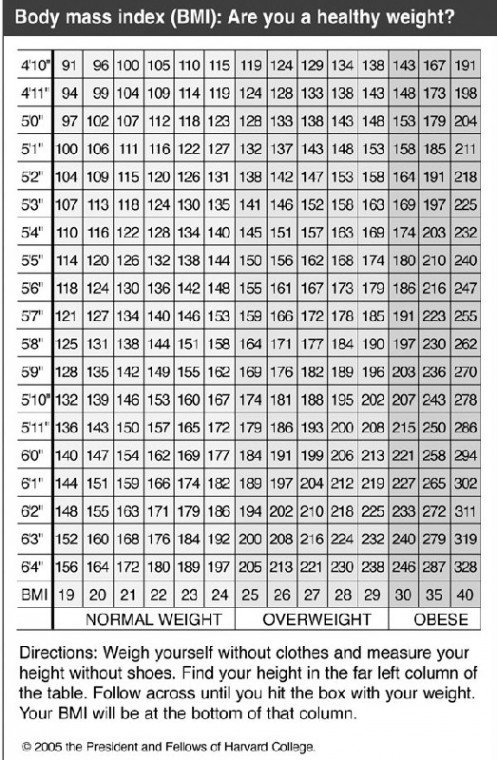Q: I’ve read that thinner people live longer and are generally
healthier. Why is this? Are there guidelines I can follow?
Q: I’ve read that thinner people live longer and are generally healthier. Why is this? Are there guidelines I can follow?
A: It’s true that thinner people live longer – up to a point. And the most important guidelines to know involve the definitions of different weight categories.
The real issue is not body weight, but body fat, as estimated by your body mass index (BMI). Your BMI is determined through your weight and your height. (You can locate your BMI by using the accompanying chart.)
American doctors used to draw the line between normal and overweight at a BMI of around 28. But recent research has proved that the following categories are more useful: BMIs below 18.5 are underweight; 18.5-24.9 is considered healthy; 25-29.9 is overweight; and 30 or above indicates obesity.
People with a healthy BMI indeed have fewer diseases and live longer than even underweight people, so avoid getting too thin. But within the healthy range, lower is better: Men and women with BMIs between 22.0 and 24.4 were found to be more likely to develop at least one of the weight-related illnesses than their leaner peers with BMIs between 18.5 and 21.9.
People who are overweight normally have more diseases and have shorter lives than people with a healthy weight: that’s why “overweight” was defined as starting at a BMI of 25 instead of 28 (the old standard).
People who are “obese” have many more diseases and live shorter lives. The list of diseases more common in obese and overweight people is long. It includes diabetes, cholesterol abnormalities, heart disease, high blood pressure, stroke, osteoarthritis, gallstones, asthma, many cancers and sleep apnea.
At present, only 35 percent of Americans have a healthy weight. Another 30 percent are overweight, 30 percent are obese and 5 percent are very obese.
Although excess fat is never good, some types of body fat are worse than others. Fat around the abdomen is the most harmful. To determine if you have too much of the worst fat, calculate your waist-to-hip ratio.
First, with your abdomen relaxed, measure your waist at its narrowest, which is usually at the navel. Next, measure your hips at their widest, usually at the hip bones. Finally, divide your waist size by your hip size to learn your ratio.
What does your ratio mean? The higher the ratio, the higher the risk of heart attack and stroke. This risk increases progressively in men with ratios above 1.0 and in women with ratios above 0.8.
Your waist-to-hip ratio provides additional information to consider along with your BMI. If both your BMI and your waist-to-hip ratio are high, you could benefit from shaping up.
The only way to reduce your abdominal fat is to reduce fat across your entire body: operations like liposuction and “tummy tucks” will not improve your metabolism or your health. That’s because these operations cannot remove the deeper fat around your organs, where it counts most.
Helpful tips
The solution is the same program that’s so good for other aspects of your health.
• First, set reasonable goals. A BMI of 22 and a waist-to-hip ratio of 0.8 would be great, but they’re not possible for many. For the short term, pick the healthiest weight that you were able to sustain for a year in adulthood and aim to reach it again.
• Second, be patient but persistent. Adopt the healthy habits you need slowly and gradually. Aim to lose a half to one pound a week. It may not sound like much, but over the course of six months to a year, you’ll make great gains.
• Third, realize that diet and exercise are equally important. Nearly everyone who wins at weight loss does both. To lose weight, you’ll have to reduce the number of calories you eat. Try to get your dietary fat down below 30 percent of your daily calories, and favor healthful fats such as those in olive oil, fish and nuts.
And don’t get hung up on carbohydrates; it’s wise to cut down on simple sugars and other rapidly absorbed carbohydrates, but don’t deprive yourself of the many benefits of whole grains.
Maintaining weight loss means doing something for your body nearly every day. A brisk, daily 30-minute walk is great for your health, but to really take the pounds off, consider picking up your pace or extending your walk to 45 minutes or an hour.
Bear in mind that you don’t have to be extremely thin to reap rewards. Set realistic goals for your weight and work patiently to achieve them, and then enjoy the health benefits and personal satisfaction that come from even modest weight loss.
Submit questions to the Harvard Medical School Adviser at www.health.harvard.edu/adviser. Unfortunately, personal responses are not possible.












